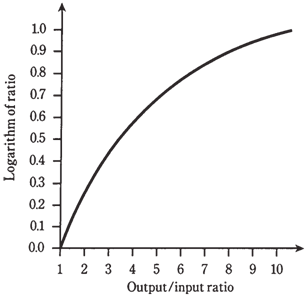The decibel
The extent to which the circuit amplifies is called as amplification factor. This can be given as a simple number, like 100, meaning that output signal is 100 times strong as the input. Often amplification factor is specified in units called as decibels, denoted dB.It is important to keep in mind what is being amplified: voltage, current, or power. Circuits are designed to amplify one of these signals, but not necessarily the others. In a the given circuit, amplification factor is not same for all 3 parameters.
Perception is logarithmic
You do not perceive loudness directly. Instead, you sense it in the nonlinear way. Physicists and engineers have devised decibel system, in which the amplitude changes can be expressed according to logarithm of actual value, to define relative signal strength.
Gain is assigned for positive decibel values; loss is assigned negative values. Thus, if signal A is at 6 dB relative to signal the B, then the signal A is stronger than B; if the signal A is at 14 dB relative to B, then A is weaker than B.The amplitude change of plus or minus 1 dB is about equal to smallest change a listener can detect if change is expected. If change is not expected, then smallest difference a listener can notice is around plus or minus 3 dB.

Figure--The base-10 logarithm function for output/input ratios of 1 to 10.
For voltage
Assume that there is a circuit with an RMS alternating current input voltage of Ein and an RMS alternating current output voltage of Eout. Then voltage gain of the circuit, in decibels, can be given by the formula:
Gain (dB) = 20 log10(Eout/Ein)
The logarithm function is abbreviated log. The subscript 10 means that base of logarithm is 10. (Logarithms can have the bases other than 10. This gets a bit sophisticated, and
it will not be discussed here.) You do not have to know mathematical theory of logarithms to compute them. All is you should buy right this minute if you do not have one, is a calculator which includes logarithm functions.
Example
A circuit has an RMS alternating current input of 1.00 V and an RMS alternating current output of 14.0 V. What is gain in decibels?
Sol:-
First, find out the ratio Eout/Ein. As Eout=14. 0 V and Ein =1.00 V, this ratio is 14.0/1.00, or 14.0. Then, find out the logarithm of 14.0. Your calculator will tell you that log14.0=1.146128036. Finally, press various buttons to multiply this number by 20, getting 22.92256071. Round off to 3 significant figures, as that is all you are entitled to: Gain22.9 dB.
For current
The current gain of the circuit is calculated in the same way as for voltage. If Iin is the RMS alternating current input current and Iout is the RMS alternating current output current, then
Gain (dB) = 20 log (Iout/Iin)
Often, a circuit which produces voltage gain will produce current loss. An excellent example is a simple alternating current transformer.Some circuits have gain for both voltage and curr
ent, although not same decibel figures. The reason is that output impedance is different from input impedance, altering ratio of voltage to current.
For power
The power gain of a circuit, in decibels, can be computed according to the formula
Gain (dB) = 10 log (Pout/Pin)
here Pout is the output signal power and Pin is input signal power.